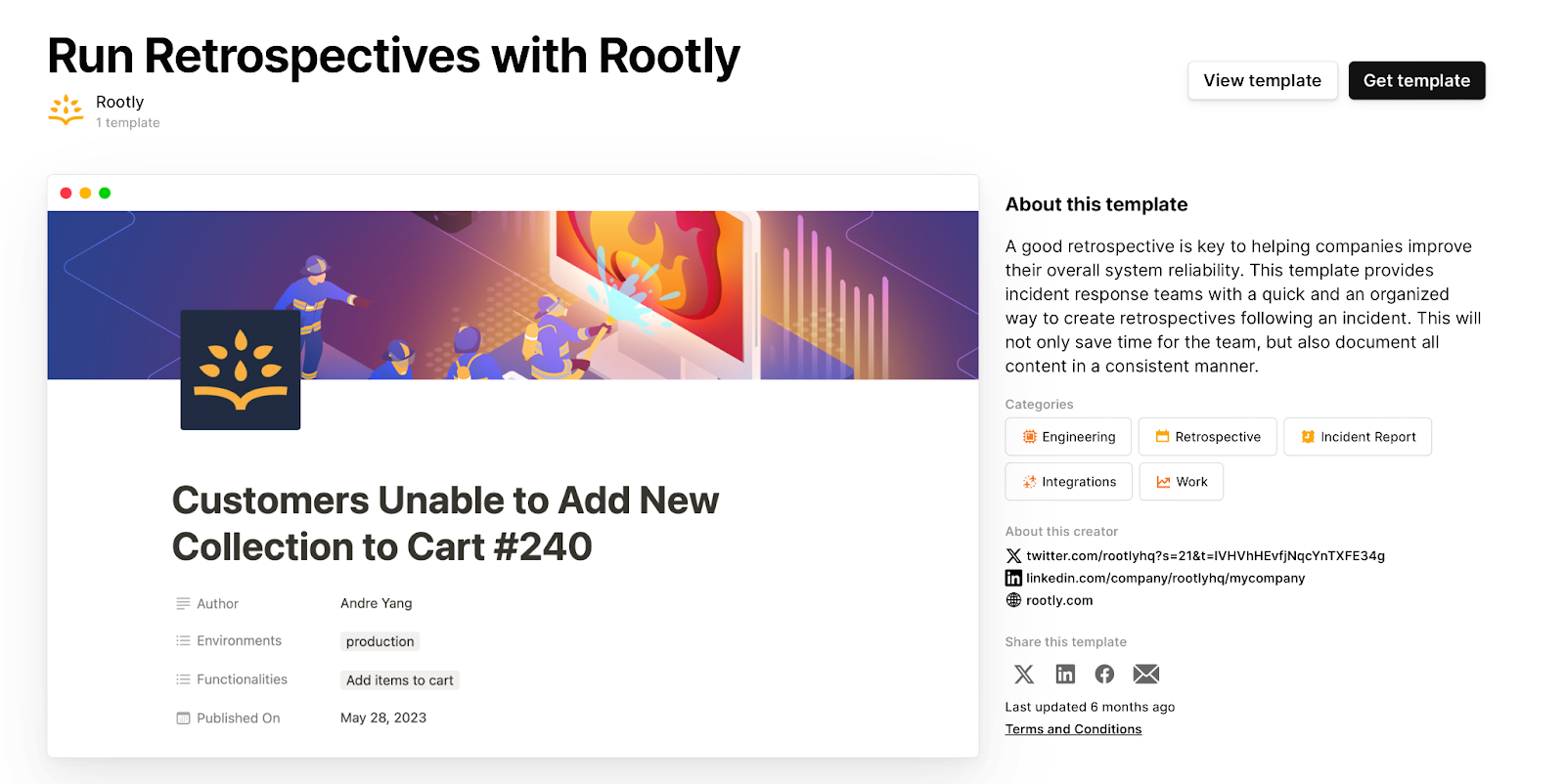Incidents are inevitable, but chaos doesn’t have to be. What separates high-performing engineering teams from the rest isn’t whether incidents occur—it’s how they respond, recover, and grow from them. An incident postmortem is more than a checkbox exercise or a formality; it’s a strategic opportunity to surface root causes, strengthen processes, and drive cultural maturity. Done right, it can transform setbacks into some of your organization’s most valuable learning moments.
Key Takeaways
- Incident postmortems are structured retrospectives that help teams turn failures into system improvements and actionable insights.
- Blameless reflection is essential to creating psychological safety and unlocking honest, productive learning.
- Severity-based thresholds ensure postmortems are used effectively without overwhelming teams.
- Templates and automation streamline retrospectives by saving time, reducing errors, and encouraging consistency.
- Rootly’s tools empower engineering teams to move faster and follow through on postmortem action items with confidence.
What Is an Incident Postmortem?

At its core, an incident postmortem is a structured retrospective held after an incident has been resolved. It involves dissecting the timeline, identifying systemic gaps, and recommending improvements. The term "postmortem" comes from the Latin post mortem, meaning "after death," but the term has evolved in tech to mean something less morbid and more constructive.
Some teams prefer "retrospective"—a term that focuses more on reflection and continuous improvement, and less on the aftermath of failure. This shift in terminology matters: it reframes the discussion to be more forward-looking and emotionally safe.
Unlike a traditional root cause analysis (RCA), which often seeks a single point of failure, postmortems prioritize systems thinking. They're about understanding how things failed—not who failed—and what can be done to ensure better resilience in the future.
When Should You Run an Incident Postmortem?
It’s not realistic to run postmortems for every single hiccup. Most teams create thresholds or criteria to determine when a retrospective is necessary:
- Severity-based triggers: Incidents that affect SLAs, uptime, or customer trust often merit deep dives.
- Service-specific rules: Critical microservices may demand closer attention.
- Commander discretion: Some teams let the Incident Commander decide whether a retrospective is warranted.
Avoid the trap of postmortem fatigue. If retros feel like burdens, teams start cutting corners or skipping them altogether. One practical approach is a tiered model: full retros for high-impact incidents, and lightweight reports or discussions for smaller ones.
Why Incident Postmortems Matter
Retrospectives do more than fix bugs—they reshape engineering culture. They help teams:
- Build institutional knowledge
- Drive systemic improvements instead of patchwork fixes
- Establish psychological safety by promoting blameless reflection
Take Crowdstrike’s recent global outage, or the massive Unisuper incident involving Google Cloud. These incidents had enormous business implications, and the postmortems that followed were dissected not just internally—but also by stakeholders, investors, and the public.
For engineers like Chris Ferraro, a former Microsoft SRE, running a truly insightful retrospective became a pivotal career moment. When done well, postmortems don’t just solve problems—they shape people.
Best Practices for Conducting Effective Postmortems

No two incidents are the same, but the highest-performing teams consistently follow a few principles:
Foster Psychological Safety
Stressful incidents often trigger emotional reactions that make learning difficult. Creating an environment where teammates feel heard and respected helps reduce fear and defensiveness. When people feel safe to speak up, you unlock honest insights and build a culture of continuous improvement.
Make Retrospectives Blameless
The goal isn't to find a scapegoat but to understand what allowed the issue to happen. Facilitators must guide conversations with curiosity and empathy to prevent blame from derailing progress. Instead of accusing, focus on uncovering gaps in systems, communication, or processes.
Right-Size the Process
Not every incident demands a marathon meeting with a dozen participants. Some situations can be addressed with a fast asynchronous summary or a 15-minute huddle. Matching the format to the severity of the incident avoids burnout while maintaining accountability.
Use Structured Templates
Templates create consistency across retrospectives and eliminate ambiguity for new contributors. They guide participants through the essential components of a successful postmortem while allowing space for customization. Rootly’s templates strike a balance between structure and flexibility, helping teams adapt to different scenarios with ease.
Automate Where Possible
Automation takes the manual burden out of tedious postmortem tasks like assembling timelines or logging action items. Tools like Rootly pull data from your incident response flow to save time and reduce human error. With integrations into platforms like Jira and Slack, follow-through becomes seamless and trackable.
6-Step Incident Postmortem Process

Step 1 – Preparation
Gather all available logs, dashboards, incident communications, and time-stamped events. These materials help paint a neutral, data-driven picture of the incident. Share them in advance so attendees can review the context and come prepared.
Step 2 – Assign Clear Roles
Clarify responsibilities early by selecting a facilitator, a note-taker, and someone to track action items. These roles ensure the meeting remains structured and productive. For complex incidents, involve legal, infrastructure, or customer teams to provide deeper insights.
Step 3 – Review the Incident
Guide the team through a factual walk-through of what happened, using the timeline as the foundation. Avoid speculative language and focus on objective observations. Foster an environment where everyone feels comfortable offering their perspective.
Step 4 – Analyze Root Cause(s)
Apply structured frameworks like the 5 Whys to dig into contributing factors. Move beyond the immediate failure to identify process gaps, team dynamics, or tool limitations. Encourage the group to explore how multiple small failures compounded into the incident.
Step 5 – Create Actionable Recommendations
Translate discussion into concrete next steps with clear ownership and due dates. Focus on actions that address systemic issues rather than isolated fixes. Use prioritization frameworks to identify which improvements will have the greatest impact.
Step 6 – Follow Up & Ensure Accountability
Make follow-through a deliberate part of the process—not an afterthought. Use tooling to assign, track, and regularly check in on action item status. Revisit outstanding items in team retros or sprint planning to prevent drift.
Leveraging Modern Tools Like Rootly
Modern incident management isn’t just about coordination—it’s about velocity, clarity, and accountability. Rootly equips SRE and platform teams with:
- Automated incident timelines (no more manual Slack scrolls)
- Jira bi-directional sync for postmortem tasks
- AI-generated summaries for faster documentation
- 70+ integrations, including Notion, Confluence, Google Docs, and more
Trusted by brands like NVIDIA, Figma, Cisco, and Elastic, Rootly helps you move from reactive firefighting to proactive reliability.
Book a personalized demo to see how Rootly can support your team’s retrospectives.
Download Our Free Postmortem Template
A good retrospective is key to helping companies improve their overall system reliability. This template provides incident response teams with a quick and organized way to create retrospectives following an incident. It not only saves time for the team but also ensures that all content is documented in a consistent, structured format.
Details from the Template Page:
- Categories: Engineering, Retrospective Meeting, Incident Report, Integrations, Meetings, Product, Documentation, IT, Work, and Docs
- Purpose: Designed to help teams document retrospectives in a quick, consistent, and organized way, saving valuable time
- Ideal Use Case: Teams looking for a fast way to document and learn from incidents without compromising depth or quality
How to Use It:
- Duplicate the free template from Notion with a single click
- Customize categories, inputs, and terminology to reflect your internal workflow
- Apply it to both lightweight and in-depth postmortems, adapting as needed for context
Rootly’s template isn’t just a blank form—it’s a practical framework that supports fast, consistent, and actionable retrospectives.
Get Rootly’s Retrospective template

.avif)























